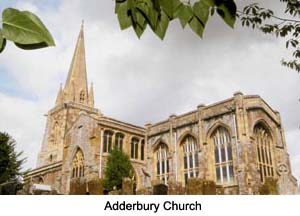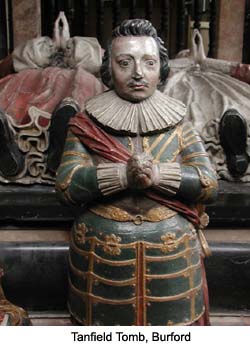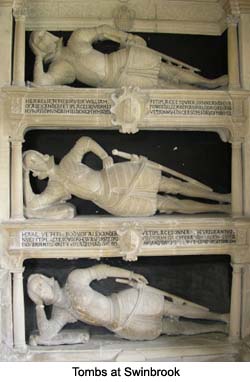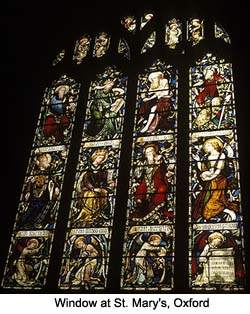The Hidden Churches of Oxfordshire
by Louise Simmons
 In north Oxfordshire, you'll find some of its
finest churches, built predominantly from the golden brown
marlstone of the English Midlands. The two medieval churches,
both called St Mary, in neighbouring towns Adderbury and Bloxham,
compete with each other in terms of the splendour, intricacy, and
sometimes eccentricity of their stone carvings. Inside and out,
14th century masons have carved ladies and knights, angels and
devils, musicians, villgers and animals of all descriptions. In
Adderbury's case, the original 13th century church and tower were
added to in the early 1400s, with a splendid chancel in the
Perpendicular style, which underwent restoration, as did other
parts of the church, in the 19th century. At Bloxham, too, the
original structure was added to some hundred years later, in this
case gaining some magnificent windows and a chapel at around the
same time (and probably due to the same person) as Adderbury's
chancel was built. It's worth having a special look at the
carvings round the windows at the west side of the north aisle,
where unusually the traceries -- the frames -- are carved both
inside and out. In north Oxfordshire, you'll find some of its
finest churches, built predominantly from the golden brown
marlstone of the English Midlands. The two medieval churches,
both called St Mary, in neighbouring towns Adderbury and Bloxham,
compete with each other in terms of the splendour, intricacy, and
sometimes eccentricity of their stone carvings. Inside and out,
14th century masons have carved ladies and knights, angels and
devils, musicians, villgers and animals of all descriptions. In
Adderbury's case, the original 13th century church and tower were
added to in the early 1400s, with a splendid chancel in the
Perpendicular style, which underwent restoration, as did other
parts of the church, in the 19th century. At Bloxham, too, the
original structure was added to some hundred years later, in this
case gaining some magnificent windows and a chapel at around the
same time (and probably due to the same person) as Adderbury's
chancel was built. It's worth having a special look at the
carvings round the windows at the west side of the north aisle,
where unusually the traceries -- the frames -- are carved both
inside and out.
Just north of Bloxham -- in fact about as far north as you can
get in Oxfordshire -- is St Etheldreda in Horley. Another golden
building typical of the area, it is not of anything like the
splendour of Adderbury or Bloxham; however it does sport one of
the best large medieval murals of St Christopher, and is worth a
visit just for that.
Further south, and over to the west, and the building material
changes to the creamier-coloured stone of the Cotswolds. At
Chipping Norton, just down the A361 from Bloxham, is another St
Mary. A church has been on this site since the 12th century,
although only the remains of an old arch on the tower wall date
from then, with most of the present building being of 13th and
14th century construction, with 15th century additions. Of
particular note is the hexagonal porch -- one of only a handful
in the country.
 Further south, at Burford,
is arguably Oxfordshire's finest parish church, that of St John.
The church benefited from the rich wool and cloth merchants of
the area, who, rather than getting together and building a
spectacular church, as happened in other places, slowly added
pieces to St John's as they desired. This perhaps makes it less
magnificent, but more attractive, and it still has plenty of
grandeur about it, although it does have a bit of a maze-like
feel about it, with multiple chapels, shrines and alters. There
are several splendid monuments, among them the
colourfully-decorated if rather controversial (and, to be honest,
ostentatious) Tanfield tomb, erected for Sir Tanfield in the
early 17th century by his widow, despite being refused permission
to do so by the church. Apparently she just sent her workmen in
anyway to build the tomb, which comprises Corinthian columns,
obelisks, and effigies of both Sir and Lady Tanfield. Amidst all
the colourful trappings on show, have a peek under the monument,
where you'll see a more down-to-earth reminder of the tomb's
function, as a carving of a skeleton lurks beneath. Keep an eye
out too for the carved panel opposite the south chapel, which has
been dated to 160 AD, supposedly illustrating an ancient Celtic
fertility goddess. Further south, at Burford,
is arguably Oxfordshire's finest parish church, that of St John.
The church benefited from the rich wool and cloth merchants of
the area, who, rather than getting together and building a
spectacular church, as happened in other places, slowly added
pieces to St John's as they desired. This perhaps makes it less
magnificent, but more attractive, and it still has plenty of
grandeur about it, although it does have a bit of a maze-like
feel about it, with multiple chapels, shrines and alters. There
are several splendid monuments, among them the
colourfully-decorated if rather controversial (and, to be honest,
ostentatious) Tanfield tomb, erected for Sir Tanfield in the
early 17th century by his widow, despite being refused permission
to do so by the church. Apparently she just sent her workmen in
anyway to build the tomb, which comprises Corinthian columns,
obelisks, and effigies of both Sir and Lady Tanfield. Amidst all
the colourful trappings on show, have a peek under the monument,
where you'll see a more down-to-earth reminder of the tomb's
function, as a carving of a skeleton lurks beneath. Keep an eye
out too for the carved panel opposite the south chapel, which has
been dated to 160 AD, supposedly illustrating an ancient Celtic
fertility goddess.
Just next to Burford is the village of Widford. It would be easy
to miss the church of St Oswald -- very easy, in fact, since you
can only get to it on foot -- but, despite its unprepossessing
appearance, that would be shame. The mainly 13th century church
(although there is still evidence of the original 11th century
building) is small, peaceful and simple. Apart from the fact that
it is built over the top of a Roman villa or temple, and the
floor mosaics under the chancel are in a remarkably good state of
preservation. Speculation is rife as to whether St Oswald's sits
on the site of some ancient Christian shrine: fortunately (from a
romantic point of view, anyway), nobody knows.
 While
you're walking, keep going about half a mile to Swinbrook, a
pretty little village complete with cricket green. The church
(another St Mary) at first glance appears to be nothing
startling: inside is a different story. There are two monuments,
each dedicated to three members of the Fettiplace family, which
date from the 17th century, and without wishing to offend anyone,
look rather ridiculous. Each monument comprises three effigies,
lounging on their sides on shelves one above the other, looking
out at visitors. They are really quite amazing. While
you're walking, keep going about half a mile to Swinbrook, a
pretty little village complete with cricket green. The church
(another St Mary) at first glance appears to be nothing
startling: inside is a different story. There are two monuments,
each dedicated to three members of the Fettiplace family, which
date from the 17th century, and without wishing to offend anyone,
look rather ridiculous. Each monument comprises three effigies,
lounging on their sides on shelves one above the other, looking
out at visitors. They are really quite amazing.
Heading back to the hustle and bustle, follow the A40 east to
Oxford itself and yet another St Mary. The University Church of
St Mary, which stands in the centre of the old walled city, has
only been standing since the 13th century -- the tower, dating
from 1280 is the oldest part of the existing church -- but it's
believed that a church has been on that site since about 600
years before then. The tower is intricately decorated, much of
the decorative carving being added early in the 14th century, and
the views over Oxford from the top (if you can manage the
124-step climb) are enhanced by the chance to see some of the
carvings close up. The other most decorative part of St Mary's is
the 17th century Virgin Porch, famous for its barley-sugar-shaped
spiral columns, and the statue of the Virgin and Child above the
door -- the bullet holes made by Cromwell's troops are still
visible.
Heading south from Oxford, towards Dorchester, and styles and
building materials change again as you get closer to the Thames
valley. Stopping off at Iffley to see the 12th century St Mary's
(was there no end to the unoriginality in naming churches?), with
its lovely old carvings, head next for Dorchester. The Abbey of
St Peter and St Paul is reputed to be built on the site of one of
Christianity's earliest sites in England, and you can still see
parts of the original medieval abbey in its grounds. The abbey as
it stands today dates from the 12th century, with a lot of 13th
and 14th century additions. It boasts a rare lead font depicting
the apostles (though not all of them, for some reason), and an
unusual sculpture of a knight, depicted in the act of drawing his
sword. Dating from around 1280, it is uncommon in the fact that
it shows the knight actually doing something, rather than lying
recumbent or posing motionless, as is usual.
 But Dorchester's glory is
in its windows, both the medieval stained glass and the carvings
around them, particularly the Tree of Jesse in the north of the
chancel, which has sculptures carved into all the traceries. But Dorchester's glory is
in its windows, both the medieval stained glass and the carvings
around them, particularly the Tree of Jesse in the north of the
chancel, which has sculptures carved into all the traceries.
Continuing the move south through Oxfordshire, the church of
St Mary fits perfectly into the lovely little Tudor village of
Ewelme. Built by the granddaughter of the poet Geoffrey Chaucer,
Alice de la Pole, Duchess of Suffolk, in the early 15th century,
along with the school and almshouses, the church is an excellent
example of the period, and the tombs inside of the Duchess and
her father and mother are truly splendid.
Finally, heading west again, the church of St Mary at Uffington,
watched over by the famous White Horse carved into the hillside,
is a wonderful, mainly unadulterated 13th century Early Gothic
structure. Little has been added in the subsequent centuries,
unlike many churches of its age, although it has been quite
extensively restored. The spire on the tower fell down in the
1700s and has never been replaced, the octagonal tower gaining an
extra storey instead. There's a monument inside to Thomas Hughes,
author of Tom Brown's Schooldays, who was brought up in
Uffington, while poet laureate John Betjeman, who lived in the
area in the 1930s was church warden for a time. Uffington itself
is a very attractive village, with some lovely old buildings and
an Iron Age fortress -- the church is the perfect complement to
this traditional Oxfordshire village.
Related Articles:
- Oxford: A Melange of Magic, Myth and Martyrs, by Sue Kendrick
- https://www.timetravel-britain.com/articles/towns/oxford.shtml
More Information:
We regret that we no longer have the resources to maintain up-to-date links and/or hours and pricing details for the various sites and attractions listed on this website. For more information about the location(s) listed above, please use your favorite search engine or visit Wikipedia.
Louise Simmons is a Scottish freelance writer who lives in a 19th century farmhouse on the top of a hill in the middle of a sheep-farming area of central Scotland. An engineer by profession, after spending many years working in the IT industry in such unusual places as Nigeria, Russia and various oil rigs in the middle of the North Sea, she decided to take up her favourite occupation, writing, on a full-time basis, and currently writes for several online and print magazines. She particularly enjoys researching and writing about the history and culture of British people and places.
Article © 2006 Louise Simmons
Photos courtesy of Britainonview.com
|
